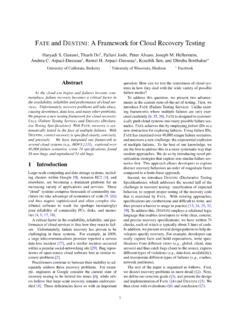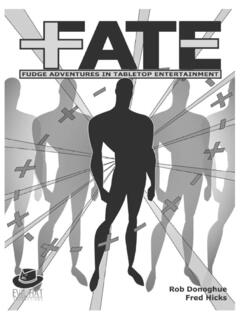Transcription of A Spark in Fate Core - Genesis of Legend Publishing
1 A Spark in Fate core Written by Jason Pitre of Genesis of Legend Publishing Based on Fate core , by Evil Hat Productions Special thanks to Fred Hicks for the token-based Facts generation. Illustrations by the many talented artists at The Noun Project Building worlds is an exciting, collaborative, and creative process. This is a hybrid system that uses the procedures of Spark RPG to support a game powered by Fate core . 1. You start by listing your favourite Media. 2. Explain the Inspirations from your media. 3. Use those inspirations to Describe the Genre. 4. Establish Facts about the Setting.
2 5. Create a Title to focus your vision. 6. Create a list of potential Issues for the setting 7. Order the Issues, picking three of them from the list. 8. Create an Aspect for each Issue. 9. Create two Faces for each Aspect. 10. Create a Place for each Spark unused. All you need to start is a blank sheet of paper, one token per person, and a group of friends. This replaces chapter 3 in Fate core . Step 1: List your Favourite Media Go around the table, and ask each person to name one of their favourite pieces of media. This could be a book, a movie, video game, comic, poem, or a song.
3 It's ok if other people don t know the media, so try to make them unique. Write these down on the sheet under the heading of Media. Step 2: Gather Inspirations Go around the table again. Now, everyone explains what they like the most about their choice. Write these down concisely in a numbered list on the sheet under the heading of Inspirations. Each person can add more Inspirations to the list if they want. This step is all about gathering ideas and brainstorming. You assemble a list of ingredients that you would like to include in the Setting. The more ingredients, the more material you have available to define the world.
4 You aren t obliged to use all of your inspirations. Step 3: Describe the Genre As a group, consider all of the inspirations and decide on some single genre for your Setting. Here are a few common genres you can pick from, though this isn t a comprehensive list. Alternate History Fantasy Modern Romance Mystery Horror Sci-fi Super-hero Once you have your genre, you get to explain what exactly makes your Setting different from others within the genre. Create a single adjective or noun that describes those differences. The best descriptors are emotional, cultural, or philosophical.
5 This step provides a common vision to interpret your inspirations and establish Facts. Write the genre and descriptor on the sheet. Step 4: Establish Facts In this step, you establish Facts about the Setting. Each Fact expresses two different inspirations on the sheet, and are established by asking a few questions. Everyone at the table should take two tokens from the supply. The GM then starts the process by asking one question about the setting. Questions must be based on the Inspirations you previously created, and ideally, they should focus on how two specific inspirations interrelate.
6 Anyone with a token may put that token forward into the middle of the table and claim the right to answer that question by creating a Fact about the setting. The best Facts are evocative, concise and specific, relating. Feel free to create some interesting names for people, event or factions, but don t feel obliged to explain them. Everyone else can offer suggestions and elaborations on that Fact, but the person who paid the token gets the final say. So long as everyone is comfortable with a Fact, write it down on the sheet under the heading of Facts. The person who just created that fact now gets to ask his or her own question and let someone else respond to it.
7 Continue to ask questions and establish Facts, until everyone has spent both their Tokens. When that happens, some common themes will emerge. This step helps you express the unique character of your Setting, and ensures that the world is filled with content that the group is interested in. Be considerate of the quieter members of the gaming group. This process is very engaging and exciting, which can lead to some people dominating the conversations. Step 5: Create a Title This is a step where you get to step back and look at the setting on a whole. Consider all of the Facts and look to see if any common ideas emerge.
8 This step helps you discuss all of the Facts and come to a common understanding of what the Setting is all about. Try to express that with a short and evocative Title for the Setting. Suggest 1-3 word titles for the game and select the best one. You should be able to express the core concept of your Setting by stating your Title, followed by Genre Description you came up with in Step 3. Title: Genre Descriptor Step 6: Create Sparks Every setting is defined by the struggle over certain key Issues. These are the broad problems that affect society on a whole, and your protagonists in specific.
9 Maybe there s some kind of broad social upheaval. Maybe there s a major culture clash, horrid disaster or demographic shift. Corrupt regimes, organized crime, a new pestilence, or a new technology all has the potential to spur the protagonists into action. Creating these issues is a communal responsibility. In this step, everyone gets a chance to create two Sparks: problems and questions that may become full Issues. These Sparks need to all relate to the Title, the Genre Description, and any Facts you have already established. As you propose these, the other people at the table will check that the Spark makes sense, and that the group is comfortable with the subject matter.
10 Write these on the sheet under the heading of Sparks. Go around the table, giving each person the chance to create their own Spark . Once everyone has contributed one, go around the table one more time so that everyone can write in their second one. When these are proposed, write them down on the sheet under the heading of Sparks. Step 7: Select the Issues Each Spark has the possibility to start a wildfire, and change the setting. The GM choose three Sparks and upgrades them into full Issues. First, she chooses one of the Sparks as a Legacy Issue. This used to be the dominant problem in the setting, and traces remain in the normal setting.









